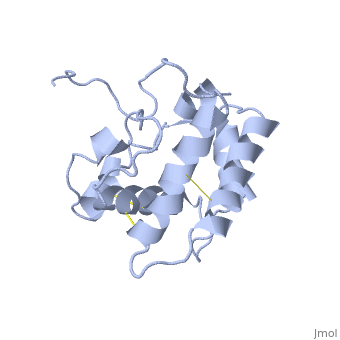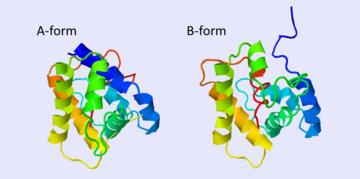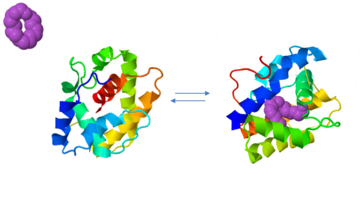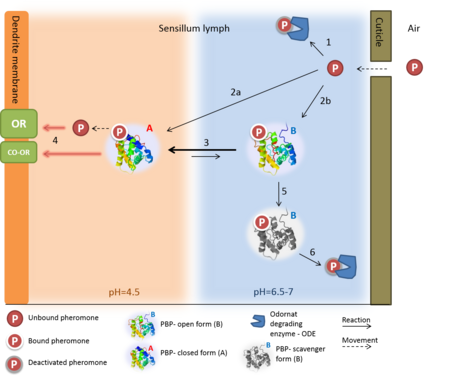Odorant binding protein
From Proteopedia
| Line 5: | Line 5: | ||
OBPs are important for insect olfaction. For instance, OBP76a (LUSH) in the fly [http://en.wikipedia.org/wiki/Drosophila_melanogaster ''Drosophila melanogaster''] is required for the detection of the pheromone vaccenyl acetate <ref name="Xu 2005">doi: 10.1016/j.neuron.2004.12.031</ref> and has been proven to adopt a conformation that activates the odorant receptor <ref name="Laughlin 2008">doi: 10.1016/j.cell.2008.04.046</ref>. | OBPs are important for insect olfaction. For instance, OBP76a (LUSH) in the fly [http://en.wikipedia.org/wiki/Drosophila_melanogaster ''Drosophila melanogaster''] is required for the detection of the pheromone vaccenyl acetate <ref name="Xu 2005">doi: 10.1016/j.neuron.2004.12.031</ref> and has been proven to adopt a conformation that activates the odorant receptor <ref name="Laughlin 2008">doi: 10.1016/j.cell.2008.04.046</ref>. | ||
| - | + | == OBP Function == | |
| - | + | ||
Despite five decades of intensive research, the exact roles of OBP and the mechanism by which the odorant receptor (OR) is activated are still in dispute <ref name="Leal">DOI: 10.1146/annurev-ento-120811-153635</ref><ref>DOI: 10.1007/s00359-009-0461-4</ref>. | Despite five decades of intensive research, the exact roles of OBP and the mechanism by which the odorant receptor (OR) is activated are still in dispute <ref name="Leal">DOI: 10.1146/annurev-ento-120811-153635</ref><ref>DOI: 10.1007/s00359-009-0461-4</ref>. | ||
| Line 26: | Line 25: | ||
| - | + | ==''Bombyx mori'' BmorPBP (lets talk about sex..)== | |
<StructureSection load='1ls8' size='340' side='right' caption='Bombyx mori PBP (PDB code [[1ls8]])' scene=''> | <StructureSection load='1ls8' size='340' side='right' caption='Bombyx mori PBP (PDB code [[1ls8]])' scene=''> | ||
Pheromone binding proteins (PBPs) are specialized members of the insect odorant-binding protein (OBP) super-family. | Pheromone binding proteins (PBPs) are specialized members of the insect odorant-binding protein (OBP) super-family. | ||
| Line 32: | Line 31: | ||
BmorPBP was first identified in the ''B. mori'' male antennae by Krieger et al. in 1996 <ref>doi: 10.1016/0965-1748(95)00096-8</ref>, as the PBP of the first sex pheromone discovered ((E,Z)-10,12-hexadecadienol, or [http://en.wikipedia.org/wiki/Bombykol Bombykol]). The male moth needs to detect minute amount of the pheromone in the air, while following a turbulent wind-born pheromone trail and response fast (experimental evidence shows a response time of 0.5 seconds<ref>doi: 10.1038/293161a0</ref>). | BmorPBP was first identified in the ''B. mori'' male antennae by Krieger et al. in 1996 <ref>doi: 10.1016/0965-1748(95)00096-8</ref>, as the PBP of the first sex pheromone discovered ((E,Z)-10,12-hexadecadienol, or [http://en.wikipedia.org/wiki/Bombykol Bombykol]). The male moth needs to detect minute amount of the pheromone in the air, while following a turbulent wind-born pheromone trail and response fast (experimental evidence shows a response time of 0.5 seconds<ref>doi: 10.1038/293161a0</ref>). | ||
| - | + | ==BmorPBP structure and function== | |
The protein has 164 amino acids that forms 6-7 alpha helices (depends on the protein conformation). Three <font color=#FFEF00><b>disulfide bonds</b></font> formed by <scene name='68/683383/Cysteins6/1'>6 cystein </scene> residues tied four helices, and form the compact and robust structure of the protein. As expected from a soluble protein, its surface is covered with <scene name='68/683383/Charged_resid/1'>charged residues</scene>, which allows it to interact with the water molecule and solubilize in the sensillar lymph. | The protein has 164 amino acids that forms 6-7 alpha helices (depends on the protein conformation). Three <font color=#FFEF00><b>disulfide bonds</b></font> formed by <scene name='68/683383/Cysteins6/1'>6 cystein </scene> residues tied four helices, and form the compact and robust structure of the protein. As expected from a soluble protein, its surface is covered with <scene name='68/683383/Charged_resid/1'>charged residues</scene>, which allows it to interact with the water molecule and solubilize in the sensillar lymph. | ||
| - | + | ==BmorPBP - ligand binding== | |
The protein natural ligand is the moth pheromone <scene name='68/683383/Bombykol_ligand_in_2p71/1'>Bombykol</scene>. However, it was demonstrated that other molecules can also bind to the protein cavity <ref>doi: 10.1016/j.str.2007.07.013</ref>. The interaction with the ligand is through 4 alpha helices 1, 4, 5 and 6 in the core of the protein, which form the binding cavity <ref>doi: 10.1016/S1074-5521(00)00078-8</ref>. | The protein natural ligand is the moth pheromone <scene name='68/683383/Bombykol_ligand_in_2p71/1'>Bombykol</scene>. However, it was demonstrated that other molecules can also bind to the protein cavity <ref>doi: 10.1016/j.str.2007.07.013</ref>. The interaction with the ligand is through 4 alpha helices 1, 4, 5 and 6 in the core of the protein, which form the binding cavity <ref>doi: 10.1016/S1074-5521(00)00078-8</ref>. | ||
Inside the binding cavity, <scene name='68/683383/Residues_interacting/1'>non-charged residues</scene> interact with the pheromone, mainly by Van der Waals bonds. Out of those residues, some are conserved across OBP of lepidopteran (<font color=#8DB600><b>in green</b></font>), and the rest are conserved in lepidopteran PBP only (<font color=#318CE7><b>in light blue</b></font>). | Inside the binding cavity, <scene name='68/683383/Residues_interacting/1'>non-charged residues</scene> interact with the pheromone, mainly by Van der Waals bonds. Out of those residues, some are conserved across OBP of lepidopteran (<font color=#8DB600><b>in green</b></font>), and the rest are conserved in lepidopteran PBP only (<font color=#318CE7><b>in light blue</b></font>). | ||
In addition, the hydroxyl group of the pheromone bombykol forms a <scene name='68/683383/Ser56_interaction_with_oxg/2'>hydrogen bond with the side chain of Ser56</scene>, Ser56 in red, oxygens are in purple (O–O distance of 2.8 Å). | In addition, the hydroxyl group of the pheromone bombykol forms a <scene name='68/683383/Ser56_interaction_with_oxg/2'>hydrogen bond with the side chain of Ser56</scene>, Ser56 in red, oxygens are in purple (O–O distance of 2.8 Å). | ||
| - | + | ==Protein conformations== | |
[[Image:A -B forms without ligand.png|thumb|upright=2|The A and B forms without ligand (PDB IDs: [[1gm0]] and [[1ls8]]).]] | [[Image:A -B forms without ligand.png|thumb|upright=2|The A and B forms without ligand (PDB IDs: [[1gm0]] and [[1ls8]]).]] | ||
[[Image:A to b with ligand.png|thumb|upright=2|The A and B forms with ligand (PDB IDs: [[1gm0]] and [[1ls8]]).]] | [[Image:A to b with ligand.png|thumb|upright=2|The A and B forms with ligand (PDB IDs: [[1gm0]] and [[1ls8]]).]] | ||
| Line 50: | Line 49: | ||
| - | + | ==Conformation transition mechanism:== | |
The c-terminus of the protein bears mostly <scene name='68/683383/Hydrophobic_resid/1'>non-polar amino acids</scene>. Yet on the surface of the helix there are three exceptional amino acids: Asp-132, Glu-137, and Glu-141, which are conserved in moth PBP <ref>doi: 10.1016/j.bbrc.2005.07.176</ref>. Of these, residues <scene name='68/683383/Asp132/1'>Asp-132</scene> (and Glu-141, if present) triggers the formation of the alpha-helix upon protonation at low pH. This causes the transition from the <scene name='68/683383/B_form_with_ligand/1'>"A form"</scene>, to the <scene name='68/683383/A_form_with_ligand/1'>"B form"</scene> and the ejaculation of the ligand from the binding pocket, which is replaced by the formatted alpha helix<ref>doi: 10.1016/j.bbrc</ref>. | The c-terminus of the protein bears mostly <scene name='68/683383/Hydrophobic_resid/1'>non-polar amino acids</scene>. Yet on the surface of the helix there are three exceptional amino acids: Asp-132, Glu-137, and Glu-141, which are conserved in moth PBP <ref>doi: 10.1016/j.bbrc.2005.07.176</ref>. Of these, residues <scene name='68/683383/Asp132/1'>Asp-132</scene> (and Glu-141, if present) triggers the formation of the alpha-helix upon protonation at low pH. This causes the transition from the <scene name='68/683383/B_form_with_ligand/1'>"A form"</scene>, to the <scene name='68/683383/A_form_with_ligand/1'>"B form"</scene> and the ejaculation of the ligand from the binding pocket, which is replaced by the formatted alpha helix<ref>doi: 10.1016/j.bbrc</ref>. | ||
Studies on other lepidopterans that show a similar pH dependent conformation suggests that this model is a general model moth PBP<ref name="Leal" />. Nonetheless, the enormous diversity among insects is not allowing us to assume this model is true for all insects' OBPs. | Studies on other lepidopterans that show a similar pH dependent conformation suggests that this model is a general model moth PBP<ref name="Leal" />. Nonetheless, the enormous diversity among insects is not allowing us to assume this model is true for all insects' OBPs. | ||
[[Image:N model extended.png|thumb|upright=2.5|Figure 1. The events prior the neuron excitation, following the "N model" suggested by Kaissling (2009)<ref name="kaissling">DOI: 10.1007/s00359-009-0461-4</ref> The pheromone enters the sensillar lymph through a pore in cuticle. The pheromone can then be degraded by the ODE (1) -or- bind to the A and B protein forms (2a and 2b, respectively). When the complex arrives at the low pH near the membrane, the transition is in favor of the A-form, (3) in which the -c-terminus is forming an alpha helix inside the binding cavity, pushing out the pheromone. The activation of the complex of odorant receptor and coreceptor (OR:Orco), is induced by ether the complex of pheromone-PBP, or by the pheromone alone (5, two options). The B-form can also act as a scavenger, as it mediates the deactivation of the pheromone (6) and releases it to the ODE (6)]] | [[Image:N model extended.png|thumb|upright=2.5|Figure 1. The events prior the neuron excitation, following the "N model" suggested by Kaissling (2009)<ref name="kaissling">DOI: 10.1007/s00359-009-0461-4</ref> The pheromone enters the sensillar lymph through a pore in cuticle. The pheromone can then be degraded by the ODE (1) -or- bind to the A and B protein forms (2a and 2b, respectively). When the complex arrives at the low pH near the membrane, the transition is in favor of the A-form, (3) in which the -c-terminus is forming an alpha helix inside the binding cavity, pushing out the pheromone. The activation of the complex of odorant receptor and coreceptor (OR:Orco), is induced by ether the complex of pheromone-PBP, or by the pheromone alone (5, two options). The B-form can also act as a scavenger, as it mediates the deactivation of the pheromone (6) and releases it to the ODE (6)]] | ||
| - | + | ==Receptor activation== | |
The insect odorant receptor is a heteromer composed of a single ligand-binding OR and the OR coreceptor Orco <ref name="Larsson ">DOI: 10.1016/j.neuron.2004.08.019</ref>. Orco acts as a [http://en.wikipedia.org/wiki/Chaperone_%28protein%29 chaperone] and also play a role in signal transduction <ref>doi: 10.1038/nature06861</ref>. The activation of this complex begins the intracellular signal transduction. Two theories have been proposed for the activation of the odorant receptors located on the dendrite membrane. One theory suggests that the pheromone-PBP complex is needed for the activation of the OR:CO complex, while the second theory argues that the pheromone itself is sufficient for the activation of the OR:CO. | The insect odorant receptor is a heteromer composed of a single ligand-binding OR and the OR coreceptor Orco <ref name="Larsson ">DOI: 10.1016/j.neuron.2004.08.019</ref>. Orco acts as a [http://en.wikipedia.org/wiki/Chaperone_%28protein%29 chaperone] and also play a role in signal transduction <ref>doi: 10.1038/nature06861</ref>. The activation of this complex begins the intracellular signal transduction. Two theories have been proposed for the activation of the odorant receptors located on the dendrite membrane. One theory suggests that the pheromone-PBP complex is needed for the activation of the OR:CO complex, while the second theory argues that the pheromone itself is sufficient for the activation of the OR:CO. | ||
| - | + | ==Activation by the pheromone alone== | |
This model is supported by the pH dependent conformation transition, that is described above. The bulk of the sensillar lymph is in neutral pH (6.5-7), while environment near the dendrite membrane bears a low pH (4.5), due to the negative charges on the surface of the membrane <ref>DOI: 10.1016/0040-8166(84)90004-1</ref>, which cause the accumulation of positively charged cations near the membrane surface (20-50 nm)<ref name="kaissling" />. According to this model, the pheromone enters the sensillar lymph through a pore in the cuticle, then it can be either degraded by odorant degrading enzymes (ODE) or bind to a PBP (of both forms). Once the complex arrives to the low pH environment near the dendritic membrane the PBP will shift to the A-form, thereby releasing the ligand from the binding pocket, allowing it to activate the OR:CO-OR complex and the cellular signal transduction begins. | This model is supported by the pH dependent conformation transition, that is described above. The bulk of the sensillar lymph is in neutral pH (6.5-7), while environment near the dendrite membrane bears a low pH (4.5), due to the negative charges on the surface of the membrane <ref>DOI: 10.1016/0040-8166(84)90004-1</ref>, which cause the accumulation of positively charged cations near the membrane surface (20-50 nm)<ref name="kaissling" />. According to this model, the pheromone enters the sensillar lymph through a pore in the cuticle, then it can be either degraded by odorant degrading enzymes (ODE) or bind to a PBP (of both forms). Once the complex arrives to the low pH environment near the dendritic membrane the PBP will shift to the A-form, thereby releasing the ligand from the binding pocket, allowing it to activate the OR:CO-OR complex and the cellular signal transduction begins. | ||
| - | + | ==Activation by the complex pheromone-PBP== | |
An alternative mode of action was proposed for the receptor activation in ''Drosophila melanogaster'', where it was found that the complex of pheromone-PBP is required for the activity of pheromone-sensitive neurons <ref>DOI: 10.1016/j.neuron.2004.12.031<ref/><ref>doi: 10.1016/j.cell.2008.04.046<ref/> | An alternative mode of action was proposed for the receptor activation in ''Drosophila melanogaster'', where it was found that the complex of pheromone-PBP is required for the activity of pheromone-sensitive neurons <ref>DOI: 10.1016/j.neuron.2004.12.031<ref/><ref>doi: 10.1016/j.cell.2008.04.046<ref/> | ||
Revision as of 09:43, 8 June 2016
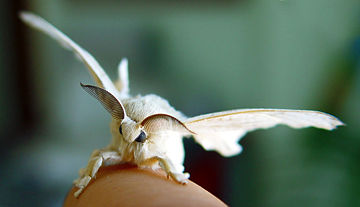
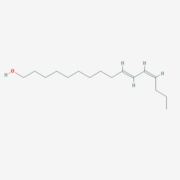
Contents |
Introduction
Odorant-binding protein (OBP) are soluble proteins which are involved in the processes of odorant detection in the olfactory sensilla [1]. Though functionally the same, vertebrates and insects OBP have different origin and structure. OBPs are important for insect olfaction. For instance, OBP76a (LUSH) in the fly Drosophila melanogaster is required for the detection of the pheromone vaccenyl acetate [2] and has been proven to adopt a conformation that activates the odorant receptor [3].
OBP Function
Despite five decades of intensive research, the exact roles of OBP and the mechanism by which the odorant receptor (OR) is activated are still in dispute [4][5].
A few functions have been suggested for OBP:
1. Solubilizing the odorant molecule and its transportation in the sensillar lymph.
2. Protecting the odorant molecule from the odorant degrading enzymes, in the sensillar lymph.
3. Activating the odorant receptor on the dendrite membrane, by the odorant-OBP complex.
4. Mediating the deactivation of the odorant molecule after the activation of the receptor.
5. An organic anion (the protein has 9 negative charges).
Of all, the first role of OBP as an odorant solubilizer and carrier is generally accepted.
In order to explain the structure and function of these fascinating proteins, this page will further focus on a particular OBP - the well investigated Bombyx mori pheromone binding protein: BmorPBP.
Bombyx mori BmorPBP (lets talk about sex..)
| |||||||||||
3D structure of odorant binding protein
Updated on 08-June-2016
See also
- Odorant_binding_protein_3D_structures
- Chemical communication in arthropods
- Pheromone binding protein
- Bovine odorant binding protein
References
Proteopedia Page Contributors and Editors (what is this?)
Nurit Eliash, Michal Harel, Joel L. Sussman, Alexander Berchansky, Jaime Prilusky
